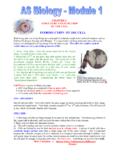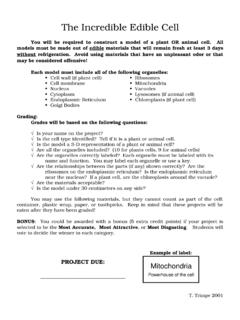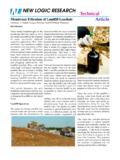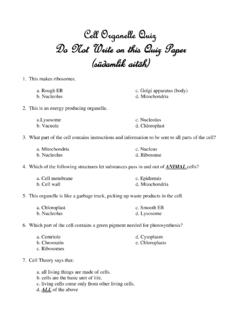Transcription of Cell Cycle - Axolotl Academic Publishing Co
1 Chapter 15, Cell Cycle , version 229 The Prokaryotic Cell CycleCells, whether prokaryotic or eukaryotic, eventually reproduce or die. For prokaryotes, the mechanism of reproduction is relatively simple, since there are no internal organ-elles. The process consists of three distinct but short phases: first, a growth phase in which the mass of the cell is increased, then the chromosomal replication phase, and finally the chromosomes are separated and the cells are physically split into two inde-pendent new cells . In bacteria, these are referred to as the B, C, and D periods, respec-tively. Initiation of the reproductive process appears to be primarily a function of cell size. The length of the overall cell Cycle is determined by the B period, as the C and D periods have relatively fixed time constraints. The length of B is determined, in part, by environmental conditions and the gain in cell mass. Generation times for bacteria can vary from under half an hour to several days, although most bacterial cultures in laboratory settings and nutrient-rich media have generation times under a replication has already been covered in detail in chapter 7.
2 In bacteria, the pro-cess is initiated at the origin of replication by DnaA. However, in archaea, synchronous initiation of replication at multiple sites on the chromosome as well as recognition proteins homologous to eukaryotic ORC proteins suggests that there are similarities between archaebacterial and eukaryotic DNA replication to be the DNA is replicated and moved to opposite sides of the cell, the midcell septum forms to split the cell. At least 9 gene products are involved in this process including FtsZ, the prokaryotic tubulin homologue that forms a circumferential ring, FtsI, a pepti-doglycan synthetase involved in septum formation, FtsL, whose function is unclear but is involved in ingrowth of the cell wall at the septum, and ZipA, which anchors the FtsZ ring. The ring contracts, pulling the membrane in with it. Eventually the membrane is pinched in enough to fuse and generate two completely separate cytoplasmic compart-ments. Other septation enzymes make cell wall components that fill in as the septum forms simultaneously with membrane/FtsZ contraction, and the cells separate.
3 Cell Cycle :Life Cycle of the cell and GametogenesisUsing this book: This book is designed to be used in both introductory and advanced cell biology courses. The primary text is generally on the left side of the vertical divider, and printed in black. Details that are usually left to an advanced course are printed in blue and found on the right side of the divider. Finally, additional biomedically relevant information can be found in red print on either side of the divider. Chapter 15, Cell Cycle , version 230 The Eukaryotic Cell CycleMost eukaryotic cells undergo a reproductive Cycle to generate either another copy of themselves or to generate gametes (sex cells ), and in doing so require a complex mecha-nism to govern the safe and accurate replication of their much larger (than prokaryote) genomes. Immediately following mitosis, the newly created cells are in the G1 phase. This is largely a growth phase, during which there is a lot of biosynthesis of proteins, lipids, and carbohydrates.
4 However, there is no synthesis of new DNA at this time. G1 is the longest of the cell Cycle phases in many cell types, and most of the physiological activity of a cell happens during G1. Following G1, the next phase of the cell Cycle is the S phase, during which synthesis of new DNA occurs. In other words, the genome is being replicated during this phase; thus at the end of S phase, the cell has twice the normal amount of DNA. After S phase, the cell proceeds into G2, which provides an opportunity for the cell to perform a self-assessment and make final preparations (such as more cell growth, repairs of DNA) as necessary before it finally heads into mitosis. Mitosis, or M phase, is primarily (1) the breakdown of the nucleus, (2) re-distribution of the DNA to opposite sides of the cell, and (3) formation of two new nuclei around that DNA, and cytokinesis, the final splitting of the cell PhaseDNA ReplicationG1 PhaseCell Growth and DevelopmentG2 PhaseFurther Cell Growth and DevelopmentM PhaseMitosis and CytokinesisG2 - M Checkpoint-DNA fully replicated?
5 -Environment?G1 - S Checkpoint-Environment?-Cell large enough to divide?-DNA quality?Metaphase Checkpoint-Chromosomes attached to spindle?Figure 1. The Eukaryotic Cell 15, Cell Cycle , version 231As the cell progresses through the various phases of mitosis, and for that matter, the phases of the cell Cycle overall, it does so in a specific and controlled manner, with checkpoints that ask if the cell is ready for the next step: is it big enough, is the DNA healthy, etc. so that the cell has the best chance of generating healthy daughter example, if the cell Cycle runs too rapidly through each phase, then there is not enough time for the cell to build up its mass in preparation for reproduction, and that leads to abnormally small daughter cells , and potentially even daughter cells that are too small to survive. If a cell undergoes mitosis with damaged or mutated DNA, then that may increase the likelihood of a pathological mutation surviving and harming the organism by turning into a cancerous tumor.
6 Controlling the Cell CycleThere are three major checkpoints for cell Cycle control (fig. 1). The first regulates the transition from G1 to S phase. Recall that G1 can be a very long phase, even (in the case of G0) as long as the lifespan of the cell. However, once the cell reaches S phase, it is committed to going through S, G2, and M phases to reproduce. This is because once S phase has begun, there is more than the normal diploid complement of DNA inside the cell. Over time this would confuse the cell ( , by overexpression of duplicated genes) as it tried to use the DNA to direct RNA and protein synthesis, and it could become sick and die. The second major checkpoint regulates entry into mitosis. Once mitosis begins, most of the metabolic activity of the cell is shut down, and the cell concen-trates its resources on dividing the nuclear and cellular material equally to support the life of both resulting daughter cells . If the cell needs more time to make final repairs on the DNA or even to bulk up a little, this checkpoint can hold the cell in G2 a little longer for those things to happen.
7 Finally, the third major checkpoint occurs during mitosis, and regulates the transition from metaphase into anaphase. Since the sister chromatids are being split apart and moved to opposite poles to form the new nuclei, it is important that all of them are perfectly lined up at metaphase and the proteins holding them together have dropped off. If they do not split evenly, the daughter cells will have abnormal numbers of chromosomes (aneuploidy) usually leading to deleteri-ous is the molecular mechanism that regulates the progress of the cell Cycle ? While many of the checkpoint sensing mechanisms are still unclear, they seem to converge on two sets of proteins that act together to trigger cell Cycle advancement. These pro-teins are known as the cyclins and the cyclin-dependent kinases (cdk). As the names suggest, the cyclins are proteins that regulate progression through the cell Cycle , and Chapter 15, Cell Cycle , version 232must be present in sufficient concentration to help activate the appropriate cdk.
8 The cyclin-dependent kinase is the active, enzymatic, half of the partnership, and activates other enzymes by phosphorylation. Although the cyclins appear to be necessary for cdk activation, they are not sufficient, as there are intermediate phosphorylation and dephosphorylation steps required to activate the cdk after cyclin binding. Both the cyclins and the cdk s are families of related proteins, and they can combine in different ways to govern particular points in the cell Cycle (fig. 2). Interestingly, the intracellular level of cdks is fairly constant. The level of cyclins, on the other hand, fluctuates dra-matically depending on the state of the cell with respect to the cell methodology of some of the early experiments is perfectly suited to explaining how this works. The seminal paper in this field was a 1971 paper in J. Exp. Zool. by Masui and Markert. In it, they examined frog (Xenopus laevis) eggs that were arrested at G2. The oocytes arrest for about 8 months naturally in order to build up the mass needed to start a new organism once it has been fertilized.
9 The basic question being asked is what is causing the eggs to come out of G2 and into M phase? It was already known S PhaseDNA ReplicationG1 PhaseCell Growth and DevelopmentG2 PhaseFurther Cell Growth and DevelopmentM PhaseMitosis and CytokinesisG2 - M Checkpoint-DNA fully replicated?-Environment?G1 - S Checkpoint-Environment?-Cell large enough to divide?-DNA quality?Metaphase Checkpoint-Chromosomes attached to spindle?Cdk1 Cyclin BCdk2 Cyclin ECdk4,6 Cyclin DCdk2 Cyclin AFigure 2. Cyclins are involved in control of the cell 15, Cell Cycle , version 233that the hormone progesterone can trigger this transition, but what are the intracel-lular players in the change in cell state? Masui and Markert decided to test whether there was a cytoplasmic molecule that was responsible. They took a small amount of cytoplasm from an M-phase egg and injected it into a G2-arrested egg. This triggered the maturation of the G2-arrested egg and pushed it into M phase, even without proges-terone. The activity was called maturation promoting factor (MPF), and was hypoth-esized to be a soluble, cytosolic later experiments, other investigators attempted to find the specific protein trigger, and from there, presumably, the rest of the mechanism.
10 Fractionating the M-phase oocyte cytoplasm by column chromatography, a protein, named cyclin B, was found to rise and fall in concentration in direct synchronization with MPF activity. Furthermore, addition of cyclin B alone was sufficient to rescue MPF activity from M-phase cytoplas-mic extract that had been depleted by RNase treatment (preventing synthesis of any new proteins, including cyclin B, and abolishing MPF activity). This clearly places cyclin B in the forefront of the maturation mechanism, but there was one major issue: cyclin B had no enzymatic activity. How was it effecting the changes needed for progress from G2 to M phase?This problem was answered by experiments on a very different organism, the fission yeast, Schizosaccharomyces pombe. Because they have a very short Cycle time, a rela-tively small genome, and they can be given random mutations en masse by irradiation or chemical treatment, yeast are excellent model organisms for many types of biologi-cal study.








